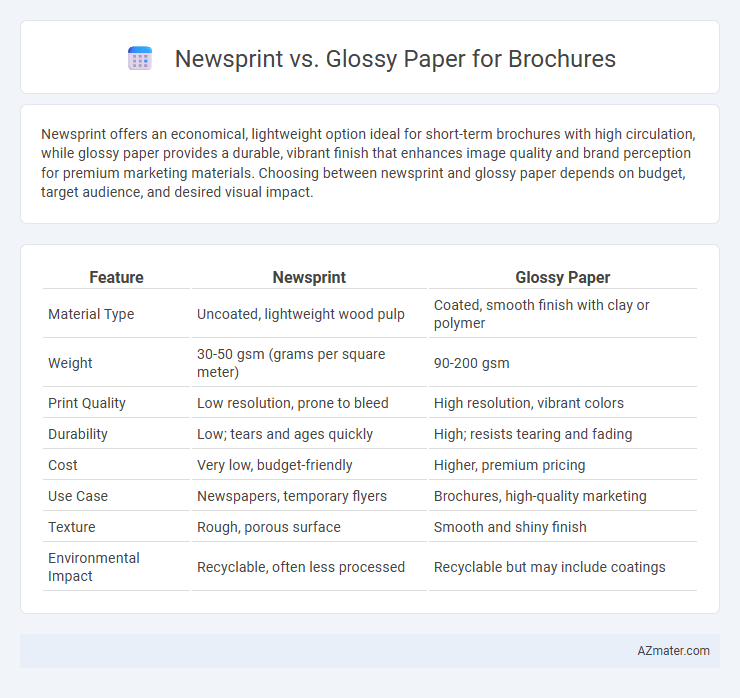Newsprint offers an economical, lightweight option ideal for short-term brochures with high circulation, while glossy paper provides a durable, vibrant finish that enhances image quality and brand perception for premium marketing materials. Choosing between newsprint and glossy paper depends on budget, target audience, and desired visual impact.
Table of Comparison
| Feature | Newsprint | Glossy Paper |
|---|---|---|
| Material Type | Uncoated, lightweight wood pulp | Coated, smooth finish with clay or polymer |
| Weight | 30-50 gsm (grams per square meter) | 90-200 gsm |
| Print Quality | Low resolution, prone to bleed | High resolution, vibrant colors |
| Durability | Low; tears and ages quickly | High; resists tearing and fading |
| Cost | Very low, budget-friendly | Higher, premium pricing |
| Use Case | Newspapers, temporary flyers | Brochures, high-quality marketing |
| Texture | Rough, porous surface | Smooth and shiny finish |
| Environmental Impact | Recyclable, often less processed | Recyclable but may include coatings |
Introduction: Choosing the Right Paper for Brochures
Newsprint offers an economical option for brochures, ideal for short-term promotions and mass distribution due to its lightweight and uncoated texture. Glossy paper enhances visual impact with a smooth, shiny finish that improves color vibrancy and image clarity, making it suitable for high-quality marketing materials. Selecting the right paper depends on budget, desired aesthetic, and the brochure's purpose to effectively communicate your brand message.
Overview of Newsprint and Glossy Paper
Newsprint is a low-cost, lightweight paper made from recycled wood pulp, commonly used for newspapers and mass-distributed brochures due to its absorbent, matte finish. Glossy paper features a smooth, shiny coating that enhances color vibrancy and image sharpness, making it ideal for high-quality, visually striking brochures. The choice between newsprint and glossy paper impacts durability, print quality, and overall presentation, influencing the brochure's effectiveness in marketing and communication.
Print Quality: Clarity and Color Vibrancy
Glossy paper delivers superior print quality with enhanced clarity and vibrant colors, making images and graphics stand out sharply in brochures. Newsprint tends to produce muted colors and lower resolution, suitable for large volumes but compromising visual impact. For brochures requiring crisp details and rich hues, glossy paper is the optimal choice to attract and engage readers effectively.
Durability and Longevity Comparison
Newsprint paper is highly absorbent and prone to yellowing and tearing over time, making it less durable for brochures intended for long-term use. Glossy paper features a coated surface that resists moisture, smudging, and fading, significantly enhancing the brochure's longevity and visual appeal. Choosing glossy paper ensures brochures maintain their quality and readability through extended handling and exposure.
Cost Analysis: Newsprint vs Glossy Paper
Newsprint offers a significantly lower cost per unit compared to glossy paper, making it ideal for large-volume brochure printing on a tight budget. Glossy paper, though more expensive due to its higher-quality finish and durability, enhances color vibrancy and image clarity, justifying its cost for premium marketing materials. Evaluating print run size and target audience impact helps determine the most cost-effective choice between newsprint and glossy paper.
Environmental Impact and Sustainability
Newsprint paper is typically more environmentally friendly due to its higher recycled content and biodegradability, reducing landfill impact. Glossy paper often contains chemical coatings and plasticizers that hinder recycling processes and contribute to longer decomposition times. Choosing newsprint for brochures supports sustainability efforts by minimizing resource consumption and enhancing recyclability.
Audience Perception and Brand Image
Newsprint offers a cost-effective solution for brochures aimed at budget-conscious audiences, conveying a raw, authentic brand image valued by eco-friendly and grassroots organizations. Glossy paper enhances visual appeal and perceived quality, attracting premium customers and reinforcing a sophisticated, professional brand identity through vibrant color reproduction and smooth texture. Audience perception shifts significantly with paper choice; newsprint suggests practicality and approachability, while glossy paper signals exclusivity and attention to detail.
Suitability for Different Brochure Purposes
Newsprint offers an economical option ideal for short-run, mass-distribution brochures where cost-efficiency and fast printing are priorities, but it lacks durability and vibrant color reproduction. Glossy paper enhances visual appeal with high-quality color saturation and sharp images, making it suitable for marketing materials, product catalogs, and premium brochures that require a professional and polished finish. Choosing between newsprint and glossy paper depends on the brochure's purpose, target audience, and budget constraints, balancing cost with visual impact and longevity.
Production and Printing Considerations
Newsprint offers cost-effective, high-speed production ideal for large-volume brochure printing, utilizing absorbent fibers that require less drying time but may result in lower image sharpness. Glossy paper demands more precise printing techniques, such as offset or digital presses with slow drying UV inks to prevent smudging on its smooth, coated surface, enhancing color vibrancy and detail. Production costs rise with glossy paper due to higher material quality and slower press speeds, impacting overall project budget and turnaround time.
Conclusion: Making the Best Choice for Your Brochure
Choosing between newsprint and glossy paper for your brochure depends on your budget, target audience, and desired visual impact. Newsprint offers a cost-effective, eco-friendly option with a rustic charm, ideal for mass distribution and casual reads, while glossy paper provides vibrant colors and a professional finish suited for high-end brands and detailed imagery. Prioritize your marketing goals and brand identity to select the material that maximizes engagement and achieves your brochure's purpose.

Infographic: Newsprint vs Glossy Paper for Brochure
 azmater.com
azmater.com